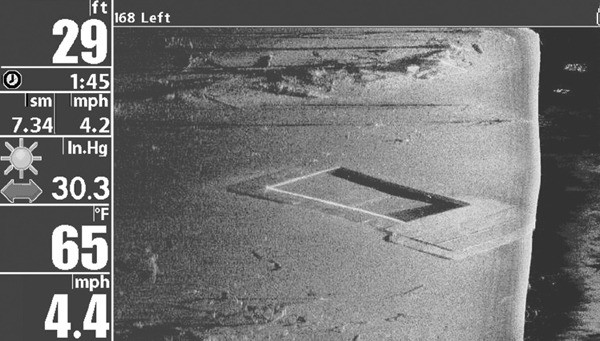
A trip to Cote Blanche bay this time of year will have you telling stories over and over again.
Imagine that your boat is a plane flying over the lake bottom taking aerial photos of the bottom through windows on both sides of its hull, and you have a rough idea of what you get from Humminbird’s new Side Imaging feature. Of course the Humminbird 900 series units that can use this feature generate the screen picture with sonar rather than a camera, but the resulting image looks more like a photograph than the views we are used to seeing on conventional fish finders.
The Side Imaging views are presented in monochrome on the units’ color screens, and I think they look at least as good as some above-water views I’ve seen through night-vision equipment.
These units give you conventional bottom views using dual frequency (50/200 kHz) vertical transducer beams. They scan out to both sides of your boat with tall, thin beams that contact the bottom about where the left and right edges of the vertical beam ends and fan on up to just below the surface. The bottom- and side-scanning transducer beams combined give you up to 180-degree (side to side) coverage under your boat.
The side beams each cover a maximum of 84 degrees, from almost straight out below the water’s surface down to where they meet the traditional cone shaped, bottom-scanning vertical beam. Each side beam is only a few degrees wide from front to back, and each time the unit “pings,” the side beam “illuminates” a thin strip of the bottom perpendicular to the boat.
This tall but skinny beam transects the water in thin slices that each provide a strip of data representing all the echoes that bounce back to the transducer.
The unit lines these strips up side by side on its display to deliver a more detailed picture than you normally get from a sounder. The thin strips of data are the secret to the feature’s ability to show such high detail. Each one could be compared to the single-slice image you can see on a medical ultrasound machine, and combining the slices together gives you a whole view of the “body” of water to either side of your boat.
The Side Imaging feature can scan out to a maximum of 240 feet in each direction over bottoms as deep as 150 feet, depending on the contour of the bottom. The side beams can be operated at 262 kHz or 455 kHz. The 262 kHz beams spread out up to 84 degrees from top to bottom, and can reach a bit farther than the 455 kHz beams. The 455 kHz beams spread out from the bottom up 40 degrees, and don’t reach as close to the surface. While they don’t cover as much water, the higher frequency beams deliver better screen detail.
The Side Imaging view scrolls from the top of the display down toward the bottom, and a small boat icon at the top center of the screen shows the boat’s position relative to the objects and topography displayed on both sides of the boat’s path. You can also display just the right or left side view across the full screen for a more detailed look.
Another option is a split screen view that shows the vertical sonar picture on one side of the screen and your choice of Side Imaging views on the other.
A Side Imaging transducer can be installed on the transom or clamped to the bottom of an electric trolling motor. The transom mount model can be used on a trolling motor with Humminbird’s trolling motor adapter kit, or an unused transom mount model can be exchanged for a trolling motor model.
Units with Side Imaging capability are designed for use in fresh or salt water. For more information, contact Humminbird at (334) 687-0503 or visit www.humminbird.com.